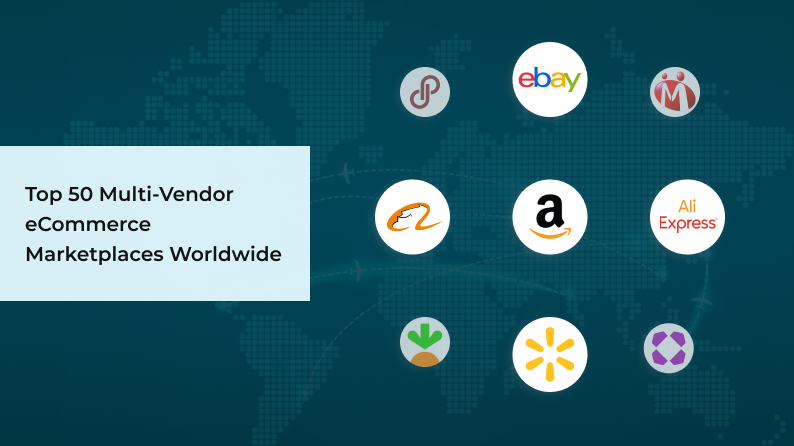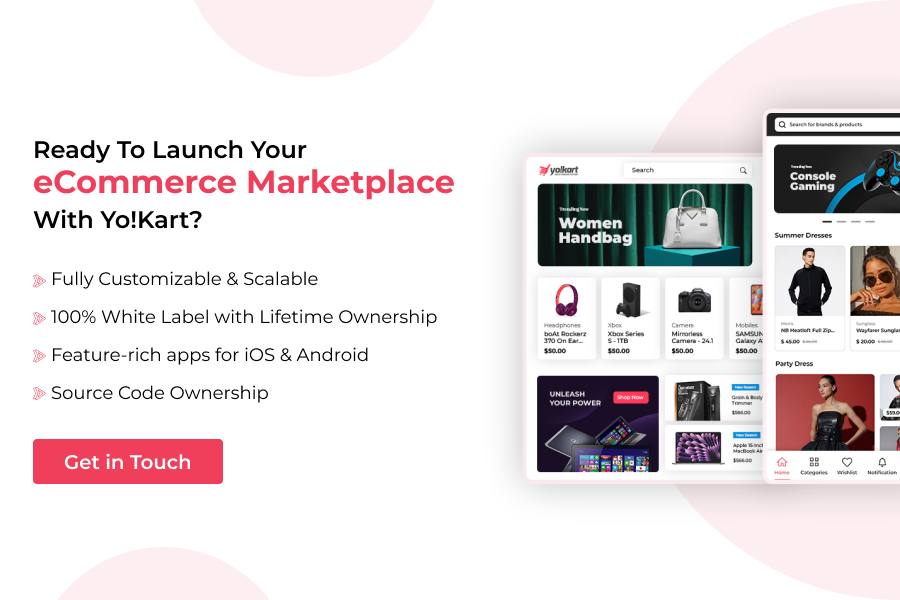In 2026, the multi-vendor eCommerce model continues to lead the global retail industry. With low entry barriers for sellers, a wide product range for customers, and scalability for owners, these marketplaces have become the go-to model for different types of business models, including B2C, B2B, C2C and more. Whether you’re planning to build your own eCommerce platform or researching successful multi-vendor marketplaces, this curated list of the top 50 multivendor eCommerce platforms globally offers insight into innovation, user experience, and market dominance.
We’ll also walk you through how Yo!Kart, a trusted multi-vendor eCommerce software, empowered 5500+ startups and enterprises by helping them build their own multi-vendor eCommerce marketplaces.
Table of Contents
Why Multi-vendor Marketplaces Dominate in 2026
Multi-vendor marketplaces have given a boost to the eCommerce industry. However, this growth is not only driven by the platform, but there are several more reasons behind it. Let’s explore the factors behind the dominance of multi-vendor marketplaces.
- Technological Advancement: Emerging technologies have empowered businesses to build a platform that can easily handle online transactions, allows sellers to list products, buyers to make purchases, and provides tools for order fulfillment. In short, it enhanced the overall online shopping experience by making it accessible via the internet. This is how the dominance of multi-vendor marketplaces begins.
- Scalable Business Model – Scalability is one of those crucial factors that attracted entrepreneurs, startups, and existing businesses to focus on the marketplaces. Easily onboard thousands of vendors without managing inventory.
- Diversified Revenue Streams – A marketplace operator can generate revenue from multiple revenue streams, including commissions, subscriptions, ads, featured listings and more.
- Marketplace Aggregation – On the one hand, sellers can list and sell products to a wide customer base. On the other hand, customers can access a wide variety at competitive pricing. In short, sellers and buyers both are getting advantages and preferring multi-vendor marketplaces.
- Lower Operational Overheads – Operating an online multi-vendor marketplace doesn’t just provide convenience and growth opportunities but is highly cost-effective. Sellers manage inventory and shipping, reducing the burden on owners.
Best 50 Multi-vendor eCommerce Marketplaces
Multivendor marketplaces have evolved across diverse regions, product verticals, and target audiences, with innovations in logistics, mobile commerce, and AI-driven personalization.
Below is a detailed list of the top 50 multi-vendor platforms worldwide, categorized by their market focus and including key parameters like:
- Primary Region
- Business Model – B2C / B2B / C2C
- Estimated Gross Merchandise Value (GMV) in 2024–25
- Category/Niche
- Type of Marketplace – Horizontal (general products) or Vertical (specific niche)
What Marketplace Niches Does This List Cover?
This curated list of Top 50 Multi-vendor eCommerce Marketplaces in 2026 spans a wide spectrum of business models, regions, and verticals. From everyday retail giants to niche industry leaders, we’ve categorized marketplaces to help you understand how multi-vendor commerce is being shaped across different sectors.
Here are the core marketplace categories and niches covered in this list:
- General eCommerce Platforms
Marketplaces like Amazon, Walmart, and Rakuten that sell a broad range of product categories—electronics, fashion, groceries, furniture, etc.
- Fashion & Lifestyle Marketplaces
Focused on apparel, accessories, luxury items, and secondhand fashion. Platforms like Etsy, Zalando, and Farfetch lead in this space.
- Grocery & Essentials Delivery
On-demand and scheduled delivery marketplaces for groceries and FMCG goods. Includes platforms like Instacart, Shipt, and BigBasket.
- Furniture, Home Decor & Living
Specialized marketplaces for home goods, furniture, decor, and DIY categories, like Wayfair and Houzz.
- B2B & Wholesale Marketplaces
Targeted at bulk buyers, manufacturers, and retailers. Platforms like Alibaba, Faire, and IndiaMART facilitate B2B transactions.
- Niche Product Marketplaces
Highly focused platforms like Reverb (musical instruments), StockX (sneakers), and NotOnTheHighStreet (gifts & crafts) that serve specific communities.
These examples illustrate the power and flexibility of the multi-vendor model—and demonstrate why it’s suitable for almost any product category or region.
GLOBAL ECOMMERCE GIANTS
| Marketplace | Primary Region | Business Model | 2024-25 GMV | Category | Marketplace Type | Description |
| Amazon | Global | B2C | $800B+ | All | Horizontal | World’s largest online marketplace with over 9.7 million sellers. Dominates in 100+ countries. |
| eBay | Global | C2C/B2C/B2B | $74B | General & Used | Horizontal | Legacy multi-vendor marketplace for used, vintage, and new goods. |
| Alibaba | Global | B2B | $780B | Wholesale | Horizontal | The go-to platform for manufacturers and importers worldwide. |
| Walmart Marketplace | US, Global | B2C | $150B | General Retail | Horizontal | Rapidly growing with 150,000+ third-party sellers. |
| AliExpress | Global | B2C/B2B | $70B | Low-cost Retail | Horizontal | Cross-border marketplace connecting Chinese vendors with global buyers. |
| Rakuten | Japan | B2C | $40B | General | Horizontal | One of Asia’s oldest marketplaces with loyalty-based shopping. |
| Etsy | Global | C2C/B2C | $14B | Handmade, Vintage | Vertical | Popular among artisan vendors with over 7 million sellers globally. |
| Mercado Libre | Latin America | B2C | $50B | General | Horizontal | Latin America’s leading eCommerce brand with logistics and fintech integration. |
| Shopee | Southeast Asia | B2C | $80B | All | Horizontal | Combines entertainment and social commerce to engage buyers. |
| Lazada | ASEAN | B2C | $30B | General | Horizontal | Alibaba-backed platform catering to regional Southeast Asia. |
Build an Online Marketplace like Amazon, eBay and Alibaba
FASHION, LIFESTYLE & ACCESSORIES
| Marketplace | Primary Region | Business Model | 2024-25 GMV | Niche | Marketplace Type | Description |
| ASOS Marketplace | UK, EU | B2C | $1.5B | Indie Fashion | Vertical | Fashion-forward multi-vendor portal for boutique brands. |
| Zalando | Europe | B2C | $14B | Apparel | Vertical | Hosts 6,000+ brands with AI personalization. |
| Farfetch | Global | B2C | $5.4B | Luxury Fashion | Vertical | Luxury goods from top-tier boutiques. |
| SSENSE | Global | B2C | $3.5B | Streetwear & Luxury | Vertical | High-end curated marketplace with exclusive drops. |
| Poshmark | US | C2C | $2.1B | Fashion Resale | Vertical | Social-powered marketplace with 8 million active sellers. |
| Depop | Global | C2C | $1.3B | Gen Z Fashion | Vertical | Secondhand fashion by individuals and influencers. |
| ThredUP | US | C2C/B2C | $1.2B | Sustainable Fashion | Vertical | Circular fashion economy backed by AI pricing tools. |
| Vinted | EU | C2C | $2.5B | Pre-loved Clothing | Vertical | Popular in Europe with a zero-seller fee model. |
| Grailed | US | C2C | $0.9B | Men’s Streetwear | Vertical | Specializes in rare streetwear & designer resale. |
| Vestiaire Collective | Global | C2C | $1.7B | Authenticated Luxury | Vertical | Authentication-powered resale platform. |
Looking for a Solution to Launch a Fashion Marketplace?
GROCERY & ESSENTIALS DELIVERY
| Marketplace | Primary Region | Business Model | 2024-25 GMV | Niche | Marketplace Type | Description |
| Instacart | US & Canada | B2C | $20B+ | Grocery | Vertical | Partners with 500+ retailers; key players in on-demand delivery. |
| Shipt | US | B2C | $5.5B | Grocery | Vertical | Owned by Target, enables multi-vendor fulfillment across states. |
| BigBasket | India | B2C | $3.8B | Grocery | Vertical | India’s leading multi-vendor grocery delivery. |
| JioMart | India | B2C | $4.5B | Grocery/FMCG | Horizontal | Integrates local stores and brands |
| Carrefour Marketplace | Europe, MENA | B2C | $7.2B | Food & Retail | Horizontal | Leading hypermarket with online multi-vendor expansion. |
| FreshDirect | US | B2C | $1.4B | Grocery | Vertical | Local sourcing and multi-vendor grocery model. |
| Ocado | UK | B2C | $3.1B | Online Supermarket | Vertical | Automated fulfillment and AI-driven personalization. |
| Blinkit (ex-Grofers) | India | B2C | $2.3B | Quick Commerce | Vertical | 10-minute delivery with hyperlocal fulfillment. |
HOME, FURNITURE & LIFESTYLE
| Marketplace | Primary Region | Business Model | 2024-25 GMV | Marketplace Type | Description | |
| Wayfair | Global | B2C | $15B | Furniture | Vertical | Hosts 11,000+ suppliers with curated vendor experience. |
| Houzz | Global | B2C | $2B | Home Design | Vertical | Features designer brands and service pros. |
| Overstock | US | B2C | $1.7B | Discount Home Goods | Vertical | Seller-led catalog for furniture and decor. |
| Made.com | EU | B2C | $800M | Designer Furniture | Vertical | Mid-luxury, vendor-manufactured products. |
| Pepperfry | India | B2C | $900M | Furniture | Vertical | India’s top online furniture marketplace. |
| Urban Ladder | India | B2C | $700M | Home Décor | Vertical | Custom-made product partnerships. |
| IKEA Marketplace (Pilot) | Select | B2C | N/A | Home | Horizontal | Experimenting with third-party sellers. |
B2B & NICHE MARKETPLACES
| Marketplace | Primary Region | Business Model | 2024-25 GMV | Niche | Marketplace Type | Description |
| Faire | Global | B2B | $2.8B | Wholesale | Vertical | Vendors connect directly with indie retailers. |
| Handshake (Shopify) | US | B2B | $1.2B | Wholesale | Vertical | Integrated with Shopify for wholesalers. |
| IndiaMART | India | B2B | $10B | Industrial | Horizontal | 5+ million suppliers and manufacturers. |
| TradeIndia | India | B2B | $2.5B | B2B Products | Horizontal | Manufacturing, packaging, and wholesale. |
| Reverb | Global | B2C | $1.1B | Musical Instruments | Vertical | Peer-to-peer musical instrument selling. |
| StockX | Global | B2C/C2C | $2B | Sneaker Resale | Vertical | High-trust seller verification and real-time pricing. |
| Tundra | US | B2B | $800M | Wholesale | Vertical | Commission-free B2B multi-vendor portal. |
| NotOnTheHighStreet | UK | B2C | $900M | Gifts | Vertical | Local vendors of handmade and creative gifts. |
| OnBuy | UK | B2C | $1.2B | General | Horizontal | Fair-pricing seller model, rising EU challenger. |
Build a B2B eCommerce Platform with Dedicated Software
Looking to Build a Multi-Vendor eCommerce Marketplace? Here’s Why Yo!Kart is the Right Choice
In today’s fast-growing digital economy, launching your own multi-vendor eCommerce marketplace can be a game-changer. Whether you’re inspired by global giants like Amazon and Etsy or niche platforms like StockX or Reverb, building a feature-rich, scalable, and user-friendly marketplace is now more achievable than ever.
That’s where Yo!Kart comes in — a powerful, fully customizable multi-vendor eCommerce platform built specifically for startups, enterprises, and entrepreneurs.
Why Choose Yo!Kart for Your Marketplace Business?
| Feature | Benefit |
| Ready-to-Launch | Start your marketplace in weeks, not months |
| 100% White-label | You can rebrand the platform as your own. |
| Self-Hosted Platform | Full control over data, features & performance |
| Source Code Ownership | You can gain access to the source code, getting complete control over the platform. |
| No Recurring Fees | One-time license cost — no monthly charges |
| Vendor Management System | Easily onboard, manage, and monitor sellers |
| Built-in Mobile Apps | Pre-built buyer & seller apps for iOS & Android |
| Integrated Payment Gateways | Supports global and local transactions |
| Tax Management | Tools to manage taxes |
| Multiple Revenue Channels | You can generate revenue via multiple revenue streams |
| Scalable Architecture | Grow from 100 vendors to 10,000+ seamlessly |
| Multi-language & Multi-currency | Launch globally with confidence |
| Marketing & SEO Tools | Drive organic traffic from day one |
Real-World Results: Brands Trusted Yo!Kart to Power Their Marketplaces
By launching thousands of successful marketplaces worldwide, Yo!Kart has become the go-to solution for entrepreneurs and enterprises looking to build scalable multi-vendor platforms.
From niche marketplaces to enterprise-grade solutions, clients across 70+ countries have used Yo!Kart to turn their eCommerce vision into a profitable reality.
Trusted by Global Businesses & Startups Alike
Explore our growing portfolio of live multi-vendor marketplaces:
View Yo!Kart Client Portfolio
You’ll find platforms built for:
- Fashion
- Grocery & Hyperlocal Delivery
- B2B Wholesale
- Electronics & Gadgets
- Creative Handmade Products
- Niche Retail Segments and others
Looking for a Readymade Marketplace Software?
Client Success Stories: From Vision to Execution
See how real businesses used Yo!Kart to solve challenges like:
- Faster go-to-market timelines
- Vendor onboarding & management
- Secure payments & localization
- Custom workflows for niche industries
“Yo!Kart’s flexibility and hands-on support made launching our marketplace seamless. It gave us the infrastructure to scale beyond our expectations.”
— Client Story from a Leading B2B Fashion Platform
Case Studies That Speak for Themselves
Explore in-depth, data-driven breakdowns of how Yo!Kart helped startups and enterprises:
- Increase vendor acquisition
- Launch marketplaces in under 10 days
- Expand across regions with multi-language support
Video Testimonials & Genuine Client Reviews
Don’t just take our word for it — hear directly from marketplace founders and teams who chose Yo!Kart:
- What challenges they faced
- How Yo!Kart delivered value
- Why they recommend it to others
Watch Client Testimonials & Read Reviews
Frequently Asked Questions (FAQs)
Q 1. What is a multi-vendor marketplace?
A multi-vendor marketplace is an online platform where multiple independent sellers list their products or services, allowing customers to buy from different vendors in a single storefront. Examples include Amazon, eBay, and Etsy.
Q 2. How do multi-vendor marketplaces make money?
Most marketplaces earn revenue through commission fees on sales, subscription plans for sellers, advertising, featured listings, and value-added services like logistics and payment processing.
Q 3. What are the advantages of running a multi-vendor marketplace?
- Low inventory risk since vendors manage their stock
- Wide product variety attracts more customers
- Multiple revenue streams for marketplace owners
- Easier to scale compared to single-vendor stores
Q 4. What are the biggest challenges in building a multi-vendor marketplace?
Common challenges include vendor onboarding and management, maintaining product quality, handling payments and commissions, ensuring seamless logistics, and delivering an excellent customer experience.
Q 5. Which industries benefit most from multi-vendor marketplaces?
Multi-vendor marketplaces are effective in diverse sectors including general retail, fashion, groceries, electronics, handmade goods, B2B wholesale, home décor, and niche markets like musical instruments or collectibles.
Q 6. How can a marketplace stay competitive in 2026?
By leveraging mobile commerce, AI-driven product recommendations, quick delivery models, personalized shopping experiences, and supporting multi-language and multi-currency features to tap into global markets.
Q 7. What key features should a multi-vendor marketplace platform have?
- Vendor and product management dashboards
- Commission and payment processing system
- Order tracking and shipping management
- Customer review and rating systems
- Mobile-friendly design and apps
- SEO and marketing tools
Q 8. Can small businesses successfully launch multi-vendor marketplaces?
Yes. With the right technology partner and strategy, small businesses can launch niche marketplaces and scale organically by focusing on underserved markets or specialized products.
Q 9. What differentiates Yo!Kart from other marketplace software?
Yo!Kart offers a self-hosted, secure, and scalable platform with built-in multi-vendor features, ready-to-launch mobile apps, flexible commission structures, and strong customization options tailored for startups and enterprises.
Q 10. How does Yo!Kart support international marketplaces?
Yo!Kart supports multi-language, multi-currency, GDPR compliance, and integrates global payment gateways, making it ideal for marketplaces targeting international buyers and sellers.
Q 11. Are there any successful marketplace case studies I can refer to?
Yes, many marketplaces are powered by Yo!Kart and have been documented in case studies showcasing rapid growth, vendor acquisition strategies, and innovative business models.




